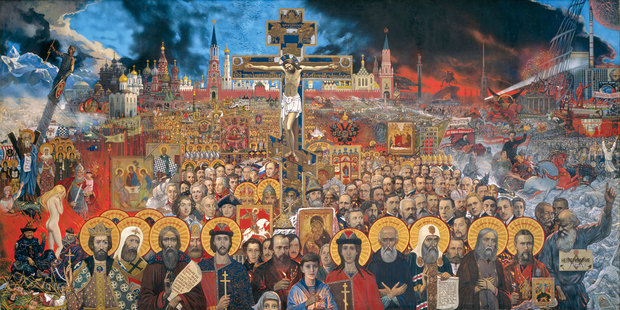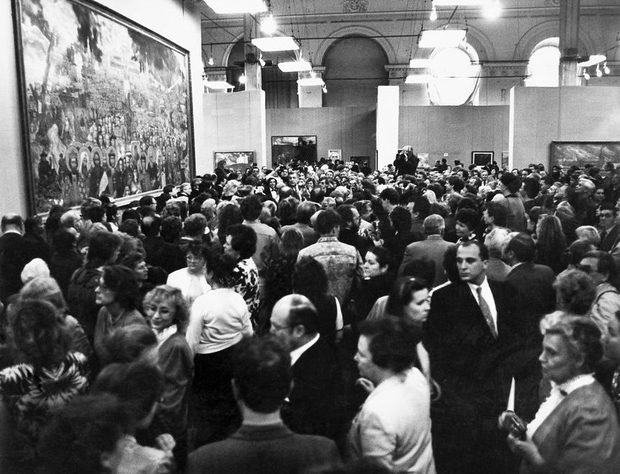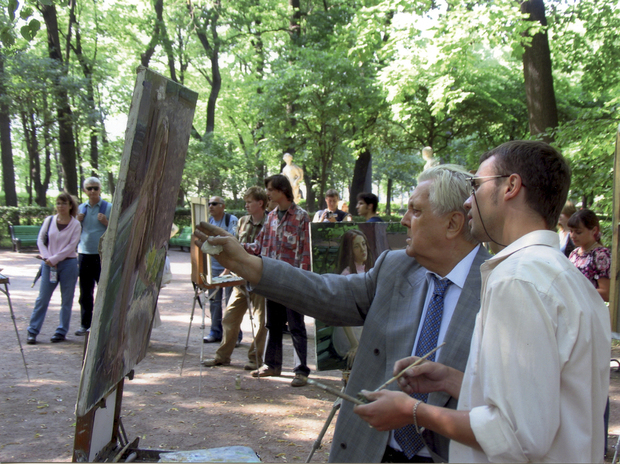Ilya Glazunov: ‘‘Who loves Russia is Russian’’
Great Russian artist Ilya Glazunov died in Moscow on 9 July from heart failure. He left nobody indifferent – he was either ardently loved or furiously hated. He also ardently loved and hated, and nobody ever saw him indifferent. Ilya Glazunov's paintings also have this passion. Realnoe Vremya tells how Ilya Glazunov will be remembered.
The Mystery of the 20th Century
Ilya Glazunov's one painting was called so — The Mystery of the 20th Century. He painted it in 1977 having witnessed student riots in Paris. To be more precise, these flames on Paris streets – they just gave an impetus, made him draw a huge painting with many figures, which, in fact, is the artist's thoughts about the craziness of the 20th century. Spectators did not see the painting for long. It was forbidden to exhibit it. And the very author was almost expelled from the country.
Probably we can say that Ilya Glazunov created a bug series of paintings, a big cycle that can be called so, that is to say, The Mystery of the 20th Century. Even working on historical paintings, he drew about the crazy century he was born in. He has a painting that can partially be called an epigraph to both the past and present centuries — The Raising of Lazarus.
Christ restored Lazarus to life who believed in him. Restored, he appears in front of people covered in a shroud, only his eyes are seen. Terror was in these eyes – indescribable fear of what he saw in this world, the world he returned to. Lazarus is afraid of resurrection.
Unfortunately, there is not serious research of art experts on Ilya Glazunov's art yet, those phenomenal contradictions that fed this art. This ''saving poison of art contradictions'' as his favourite Aleksandr Blok wrote once was his motivation. Deep, almost visionary illustrations to Dostoevsky and Blok's works, historical cycles, psychological portraits and finally The Mystery of the 20th Century, Eternal Russia, The Market of Our Democracy that appeared at the end of the last century.
He was reproached for his last paintings with many characters, which can't be considered fair. These works are Glazunov's opinion journalism, so to speak, an artistic approach he used for philosophical generalisation of historical periods. We should not approach him with traditional patterns. He knew history and philosophy very well.

On the Frunze Embankment
July 1988. Ilya Glazunov's personal exhibition was in the Youth Palace on the Frunze Embankment. The queue standing under the baking sun extended far away. I was lucky: I agreed with TV workers who came to make a piece, they gave me a tripod and I entered the hall with them.
A crowd was there, it was difficult to approach the paintings. Eternal Russia was exhibited for the first time, it was impossible to get closer to it. It was heard that somebody was speaking about the idea of the painting to the microphone – it was Glazunov's colleague and friend Pyotr Litvinsky. He put his microphone away and we miraculously turned out next to each other.
We started to talk. I asked something about the painting. He asked who I was and where I came from. When I said I was from Kazan, he immediately asked what happened to Konstantin Vasilyev's paintings there. I did not have the time to answer because the crowd that surrounded Petr Litvinsky and me was giving way. Ilya Glazunov was walking on the created corridor. Smiling, in a sky blue suit – like his eyes.
Some time later, in another hall, Litvinsky found me again and said that Ilya Glazunov would like to talk to me. We went to a small room separated by paintings. And Glazunov asked me what I knew about Vasilyev's paintings for a long time. In the past, he wanted to help the Kazan artist to enter the Surikov Institute where he taught, but something failed.

Shake
Glazunov permitted me to visit his classes in the Surikov Institute where he taught in the Portrait Department. The classes were on Saturdays. Guys came by 9 a.m., Ilya Glazunov appeared at about 11. And the shake began, as it was called then.
The students made copies of great masters, drew paintings on chosen topics. Glazunov was exacting: ''You have guys sitting near the flame, they are street children. Do you know who they are? Your paintings won't be real if you don't create a biography for every character''.
Music was always turned on in the hall. Ilya Glazunov insisted that an artist needs to know Classics. And not only in music. Glazunov's classes were amazing lectures where the Bible and history of arts, philosophy and literature were bound. His erudition and unusual mind amazed. He quoted Classics and read verses, he was paradoxical, illogical at times, he temper ran high. He constantly smoked.
By the end of the class, which had been lasting for 7 or 8 hours, all the paintings drawn by the students were put for secret voting. The students threw notes with their votes in a box. The winner would get a prize – Glazunov brought an album of reproductions, good book or a record. When the maestro went home, he took 2-3 his pupils — for dinner or to continue a talk on Kalashny Lane where he lived and his workshop was.

''I am an artist, that's why I am interesting''
Yes, he was a contradictory person, there are many myths about him. For instance, Glazunov was a Russian nationalist. It is impossible to know now where this rumour came from, and we should not do it. Glazunov was international. Russia was just his big love. He divided people by nationality and often said: ''Who loves Russia is Russian''.
In addition, he was very generous. Having made a portrait of the Pope and earned huge money, he refused it and asked to take his students from the Faculty of Fine Art of the Russian Academy of Painting, Sculpture and Architecture for practice to Vatican museums. He recreated this academy from scratch in the historical building on Myasnitsky Street. He was the rector. Now the academy bears his name. By the way, several guys from Tatarstan already graduated from it.
A painting – a woman's face, which was probably drawn with chalk – was put on the window of his workshop on Kalashny Lane, the last floor of the famous Mosselprom Building. The woman was looking at a narrow Moscow alley, a small round yard. Probably it was the portrait of his wife who had died – Nina Vinogradova- Benois. She was the only woman he really loved.
